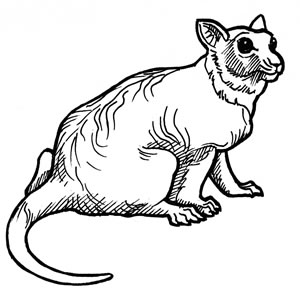65.5 Million Years Ago
 THE SCULPTURE REPRESENTS a marsupial mammal, Sinodelphys szalayi, which lived 125 million years ago. At fifteen centimetres long, they are typical of the small early mammals that barely survived in a world dominated by mighty dinosaurs. The sculpture is sitting on a piece of basalt from Antrim that dates from the Cenozoic, which began 65 million years ago, after the extinction of the dinosaurs. This extinction was largely due to a massive meteor that crashed into the earth about 70 million years ago. Following the extinction, the tiny mammals rapidly radiated into the vacant niches of the great reptiles, establishing mega-faunas on each of the continents and in the oceans. Though the mammals did take to the air in the form of bats, the skies are still dominated by birds, the one branch of the dinosaurs that remains successful.
THE SCULPTURE REPRESENTS a marsupial mammal, Sinodelphys szalayi, which lived 125 million years ago. At fifteen centimetres long, they are typical of the small early mammals that barely survived in a world dominated by mighty dinosaurs. The sculpture is sitting on a piece of basalt from Antrim that dates from the Cenozoic, which began 65 million years ago, after the extinction of the dinosaurs. This extinction was largely due to a massive meteor that crashed into the earth about 70 million years ago. Following the extinction, the tiny mammals rapidly radiated into the vacant niches of the great reptiles, establishing mega-faunas on each of the continents and in the oceans. Though the mammals did take to the air in the form of bats, the skies are still dominated by birds, the one branch of the dinosaurs that remains successful.
About 200,000 years ago, the first lines of Homo sapiens appeared, and that will be the subject of the next station.
THE MOST IMPORTANT development in the plant world, during this period, was the evolution of grasses, which co-evolved with grazing mammals. The grasses became well adapted to survive grazing, while the grazing mammals evolved high crowned teeth, adapted to a diet of abrasive grasses. This co-evolution led to the development of extensive grassland prairies and savannas, populated by fast, long legged mammals like the horses.
About 5 or 6 million years ago, the hominid lineage of upright apes began to appear among the grassland mammals of the African Rift Valley. By 3.5 million years ago, remains of Australopithecines appear, associated with simple stone tools. The genus Homo arrived about 2 million years ago and migrated into Eurasia. Their remains are associated with more sophisticated tools, some made of wood.
In Ireland, most of the sediments of this period have been scraped away by the ice sheet, which only retreated in the last 20,000 years, leaving no fossil record of the great flowering of the mammals, or of early man. The human record here begins with the arrival of Mesolithic men, after the ice melted.